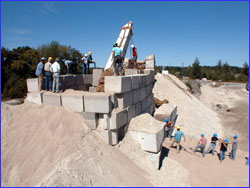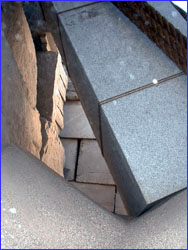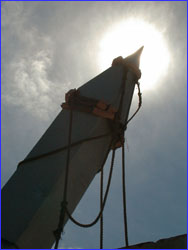
|
 |
 |
by Peter Tyson September 1, 1999 I'll cut to the chase: We got the obelisk into the turning groove just as the sun was setting last night, and it now rests at a proud angle of roughly 75°, ready for the attempt to pull it the final 15° to upright a week from Saturday. The sand-pit operation was a complete, unmitigated success. Now, I thought of writing this dispatch in such a way as to build the tension slowly, drag out the day's events, keep you guessing about how well we did, and only at the very end, just when you were becoming exasperated with not knowing the result, have Rick Brown or one of his colleagues blurt out, "We're in the turning groove!" But that's not the way it worked yesterday at the quarry. Not at all. Though the day did have its moments of heightened expectancy and muted wonder and celebratory high-fives, all in all it had about as much drama as a fencepost-raising. And that's what was so impressive about it. Brown and his crack team of timberframers, engineers, sculptors, and ready-for-anything laborers had thought of everything, had planned for everything, had tested everything. Their skill and professionalism shone through in every action. There were no disagreements, no moments of doubt, not a single unexpected surprise. The operation went like clockwork. To wit: 10:30 a.m. When I arrive at the quarry, Brown's crew has been removing the sand from the pit since Monday afternoon, and the obelisk lies at an angle of about 40°. This is already higher than crews on the two previous attempts to raise an obelisk achieved.
"We're approaching a critical threshold of 45°, when the ropes will become stressed," <Mark Lehner> tells me. This is the point at which a much greater portion of the 25-ton stone's weight begins bearing down on the three-inch ropes slung around its butt end and on the ever-lowering sand pile on which it rests. 11:45 a.m. With a sudden creak of the ropes tightening around the pivot and braking timbers, the obelisk shifts down a few more inches, stopping at an angle of 46°. Each creak is a teeth-clenching, all-bets-are-off kind of sound, as primal and unsettling and unignorable as thunder. 12:08 p.m. "Rick, what happened?" Julia Cort, the NOVA producer, calls from ground level as a loud creak and obelisk-shifting occurs and a flurry of voices is heard 20 feet above. Brown, crouching out of sight on the high wall of the sand pit, answers with the calm assurance of one fully in control: "It rolled down, rolled forward, and shifted a little bit." Just what he expected: In the team's effort to bring the obelisk flawlessly into the turning groove, those three elements are the ones he and his team are ever striving to balance, namely, guiding the obelisk butt end down toward the pedestal stone while also pivoting it back toward the ramp wall and keeping it aligned with the pedestal stone's turning groove, which remains invisible several feet down beneath the sand.
Another sit-up-and-take-notice creak of the ropes, and the obelisk lies at 52°. Though the ropes and timbers are making all the noise, the sand, on which the obelisk has rested from the get-go, is doing most of the work. Strangely, a moment comes when none of the 30 or so people on the construction and film crews is talking, and a brief, startling silence reigns over the quarry. 1:40 p.m. After a pause for lunch, we go at it again, and now there's a big leap, from 52° to 58° in one great, gut-crunching lurch. "We knew everything would intensify after 45°, and that's exactly what's happening," Brown tells me as we gaze at the ever-sinking sand. It's mesmerizing to watch the sand's angle of repose suddenly become disrupted as workers dig out the heap from below. A leading edge of cascading sand triggered by a new cavity below advances up the heap of its own accord, like a living thing. "It's very fractal," Lehner says, standing beside us. "A little avalanche within a bigger avalanche." With the operation going so smoothly, we're free to admire such a riveting force of nature. Continue: 2:30 p.m. Explore Ancient Egypt | Raising the Obelisk | Meet the Team Dispatches | Pyramids | E-Mail | Resources Classroom Resources | Site Map | Mysteries of the Nile Home Editor's Picks | Previous Sites | Join Us/E-mail | TV/Web Schedule About NOVA | Teachers | Site Map | Shop | Jobs | Search | To print PBS Online | NOVA Online | WGBH © | Updated November 2000 |
 The NOVA obelisk heads toward the heavens as
engineers atop the container wall study the ropes and
workers below remove sand from trapdoors.
The NOVA obelisk heads toward the heavens as
engineers atop the container wall study the ropes and
workers below remove sand from trapdoors.
 A shoveler's-eye view of the obelisk settling down as
sand is cleared.
A shoveler's-eye view of the obelisk settling down as
sand is cleared.
 The monolith early yesterday afternoon.
The monolith early yesterday afternoon.